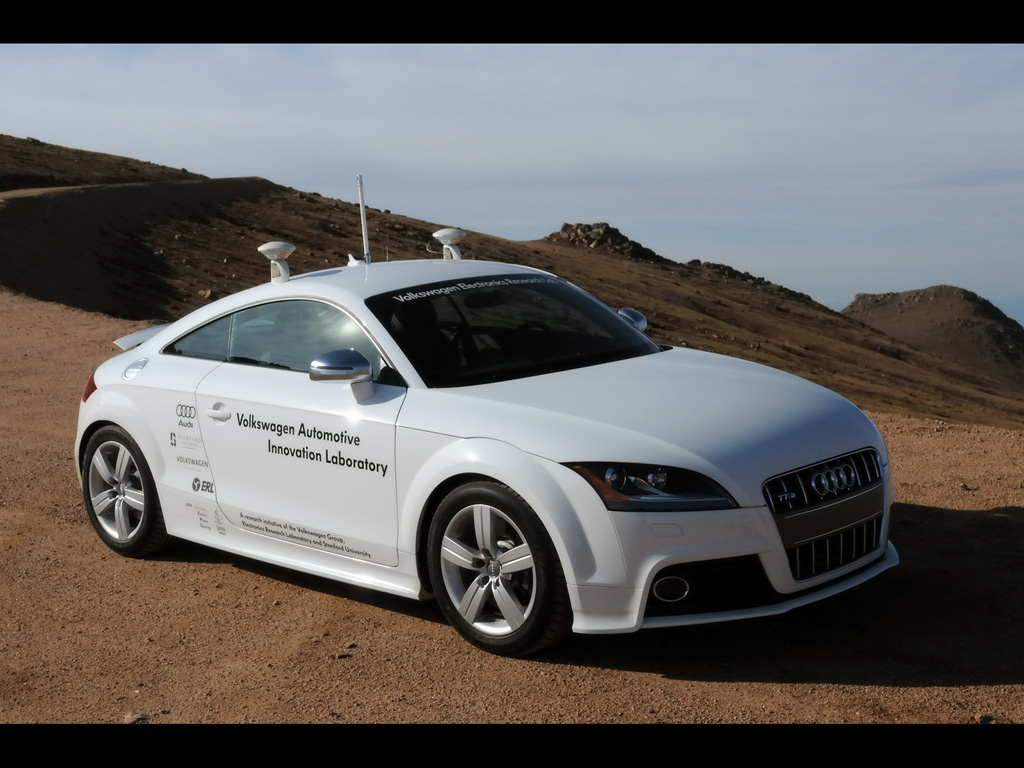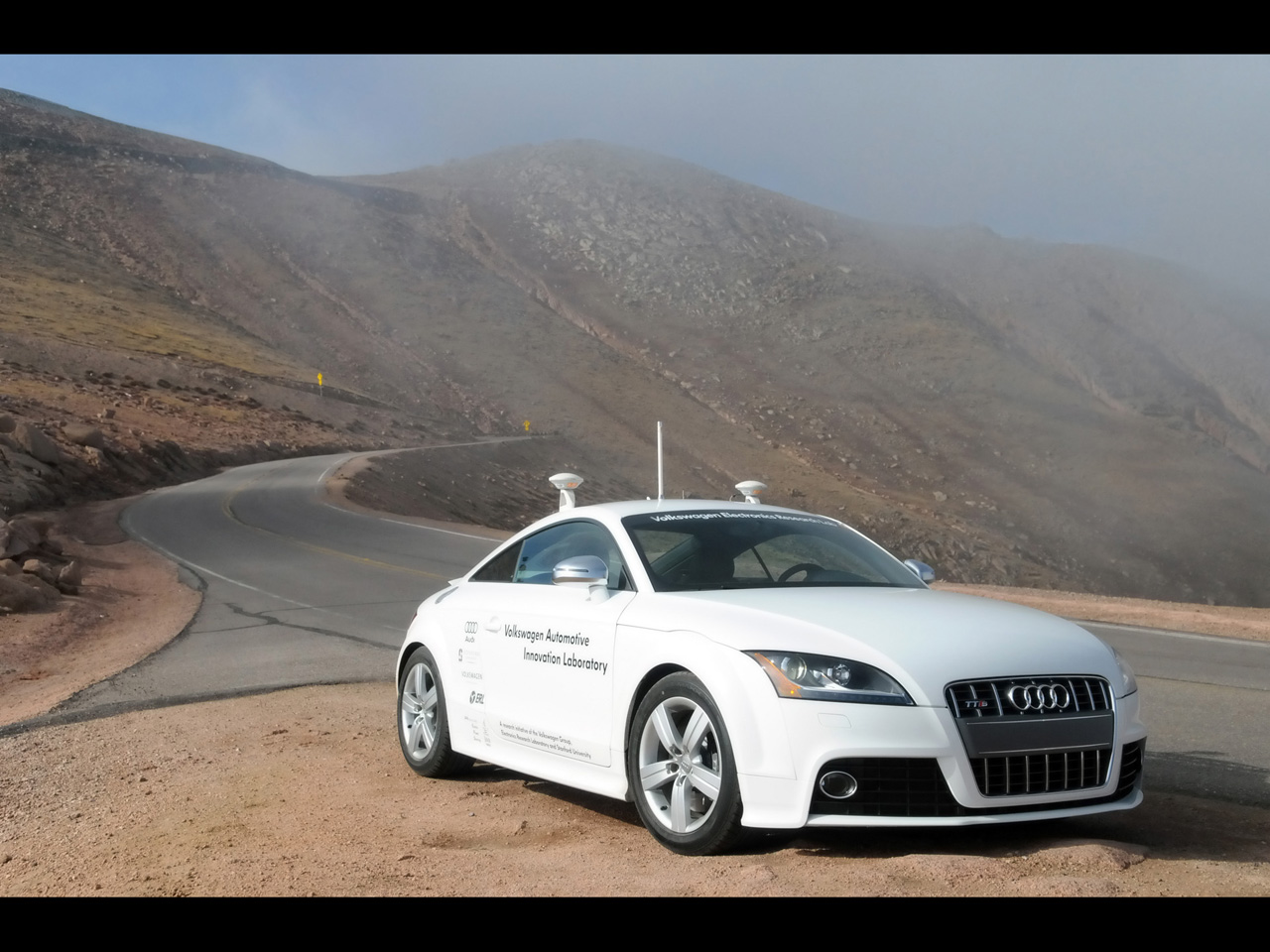2009 Autonomous Audi TTS
|
Price |
-- |
Production |
-- | ||
|
Engine |
2 liter inline-4 |
Weight |
3240 lbs | ||
|
Aspiration |
turbocharged |
Torque |
258 lb-ft @ 2500 - 5000 rpm | ||
|
HP |
265 hp @ 6000 rpm |
HP/Weight |
12.2 lbs per hp | ||
|
HP/Liter |
132.5 hp per liter |
1/4 mile |
-- | ||
|
0-60 mph |
4.9 seconds |
Top Speed |
155 mph |
(from Audi Press Release) Backgrounder on the Autonomous Audi TTS
PALO ALTO, Calif., Nov
18, 2009 - What once seemed to be the stuff of science fiction – a
car that can safely operate without direct input from a driver – is
rapidly moving from the realm of science fiction toward reality.
This is being clearly demonstrated with the Autonomous Audi TTS
coupe research project, which has become a sensation worldwide.
This car is the direct result of work underway at the Volkswagen
Group Automotive Innovation Laboratory – or VAIL – a collaborative
effort set up by the Volkswagen Group Electronics Research
Laboratory in Palo Alto, Calif., and Stanford University to advance
automotive technology.
The Autonomous Audi TTS project isn't aimed at making motorists and
the thrill of driving dispensable. Instead, it is intended to
explore the best capabilities of current and future driver
assistance technologies to help Audi enhance the experience behind
the steering wheel for generations to come.
Dr. Burkhard Huhnke, executive director of the Electronics Research
Laboratory, has noted that the technology found in the Autonomous
Audi TTS could help dramatically reduce the number of fatalities
worldwide. He also notes that it will help motorists respond more
effectively to changing traffic conditions to reduce road congestion
and allow better reactions to safety hazards. Taken to its logical
potentil, Dr. Huhnke noted, the technology could return time to the
cars’ owners by taking care of routine driving chores, such as
winding through a parking garage to an assigned spot each morning.
HIGHLIGHTS OF THE AUTONOMOUS AUDI TTS
WHY
To study how advancements in communications, driver assistance and other technologies can help motorists react to traffic and safety challenges on the road, including more autonomous handling of routine driving conditions like bumper-to-bumper congestion.
RESEARCH PARTNERS AND ROLES
Volkswagen Group
Electronics Research Laboratory (ERL)
Convert a vehicle to drive by wire,
develop a safety architecture to ensure a reliable autonomous drive
with no safety driver, and implement Stanford control algorithms on
a system jointly developed with Sun Microsystems.
Stanford University Dynamics Design Lab (SDDL), one of the member
labs of VAIL -Volkswagen Group Automotive Innovation Laboratory
Develop robust control algorithms that enable the vehicle to drive
at the limits of handling on a variety of surfaces, and lets it
drive in various speeds and conditions.
Sun Microsystems
Specify a hardware platform that can run Stanford's real time algorithms and develop a framework that enables Real Time Java (Java RTS), a combination of technologies that use the Java programming language developed by Sun Microsystems to provide a system for developing application software and deploying it in a cross-platform environment, to communicate with the vehicle CAN wiring harness and autonomous driving control system.
WHERE
The VAIL partnership is based in Palo Alto, Calif. USA. ERL and Stanford University are both located there
OBJECTIVES AND WHAT'S AHEAD
An Autonomous Audi TTS
coupe that can navigate many types of driving situations. One
intriguing demonstration under consideration for 2010 is a run up
Colorado's famous Pikes Peak to replicate the 12.4-mile Pikes Peak
International Hill Climb where Audi has demonstrated its prowess in
performance and handling. The non-competitive environment would
allow the Autonomous TTS to show its capabilities at various speeds
and conditions, including drifting.
The Autonomous Audi TTS is nicknamed after Michelle Mouton, arguably
the most successful female rally driver to date who played a
significant role in Audi Sport racing history.
TIMING
Currently in the testing phase, this vehicle and project continues its development for several still-to-be determined real-world driving challenges in 2010, including a possible drive up Pikes Peak in Q4/2010.
VEHICLE SPECIFICATIONS
Official Name:
Autonomous Audi TTS
Make and model: 2009 Audi TTS
Engine: 2.0 turbocharged FSI direct injection engine
Transmission: 6-speed S tronic double clutch transmission
Fuel Consumption: City 21 mpg / Highway 29 mpg / Combined 24
Power: 265 hp @ 6000 rpm
Torque: 258 lb-ft @ 2500-5000 rpm
Top Speed: 155 mph (249 km/h)
Acceleration 0-60 mph: 4.9 seconds
Weight incl. sensor around 1470 kg / 3240 lbs
ABOUT DRIVE-BY-WIRE
Steering:
Modified “APA-BS” (Axially Parallel Actuation-Braun-Schweig),
a new production electric power steering system with direct
by wire control through custom ERL Electronics.
Throttle: Electronics from VW ERL reproduce signals to
emulate a driver pressing on the throttle.
Brakes: Active brake booster from Continental with by-wire
control through ERL Electronics.
Gear: Modification of signals exchanged between transmission
and gear shifter using custom ERL Electronics on production
hardware.
Parking brake: Use of stock electric parking brake from VW
Passat through a custom ERL electric interface utilized on a
previous “Junior” project.
SAFETY TECHNOLOGIES
In addition to multiple
redundant systems for vehicle control and emergency shutdown, the
autonomous TTS has a Solaris based system running a Real-Time Java
System that monitors all sensors and actuators in the car and a Java
RTS sub-system that can perform a vehicle shutdown if it determines
conditions have become unsafe.
As a backup solution, the vehicle includes a telemetry system that
can transmit all vehicle parameters to a receiving station up to 20
miles away, which can also shut down the vehicle remotely, or order
the safety systems to engage and bring the car to a controlled stop.
SENSORS
The Autonomous Audi TTS utilizes an Applanix POS LV420 GPS and Inertial Measurement Unit to measure its position.
VEHICLE CONTROL
Hardware – two
independent systems are being used in the Autonomous Audi TTS, the
initial controller development is being done on an XPC target using
Matlab and Simulink, both of which are the standard research tools
from SDDL. The final vehicle controls are being run on ruggedized
custom-built solutions running a Core2Duo CPU and Solaris operating
system that is being developed in collaboration with Sun
Microsystems.
Software – The SDDL is developing cutting-edge control algorithms
that look to optimize the ability to control the vehicle under the
most demanding circumstances. As these algorithms are finalized,
they will be merged into a new framework. This framework is being
developed at the ERL that shares many components with other ERL
autonomous driving projects.
HOW MUCH
These projects are not designed around project cost, but to promote a leadership in the long-term regarding various real-world automotive topics.



